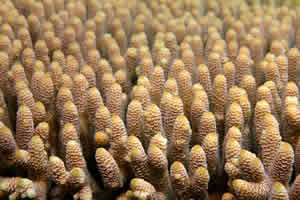
Acropora millepora Photo courtesy of Zoe Richards.
Australian scientists today announced they have sequenced the genome of the staghorn coral Acropora millepora, a major component of the Great Barrier Reef and coral reefs worldwide.
This is the first animal genome project to be carried out entirely in Australia, and is an important milestone in Australian biotechnology and in the study of coral reefs, said the researchers from the ARC Centre of Excellence for Coral Reef Studies and the Australian Genome Research Facility (AGRF).
"This is a first for Australian science. Here we show that Australia can unlock the genetic potential of its own unique fauna and flora for the national benefit," says project coordinator Kirby Siemering from the AGRF.
Corals are the backbone of the Great Barrier Reef, fascinating millions of visitors with their spectacular variety of shapes and flamboyant colours. However, they are also under threat from the effects of climate change, pollution, and disease.
"This project has both practical and scientific significance. It will help us to understand how corals build reefs â€" and why they fail to do so when they are under stress" says Professor David Miller of the ARC Centre of Excellence for Coral Reef Studies (CoECRS) and James Cook University.
"Corals have iconic significance for Australia. We have the best-preserved coral reef system in the world and the Great Barrier Reef is a cornerstone of a $6 billion a year tourist industry. As reefs elsewhere in the world decline, this value will grow if we can keep our reefs healthy and intact" explains Doctor Eldon Ball from the Australian National University (ANU).
Their study shows that corals may look like simple animals, but their DNA is surprisingly complex. In fact, David Miller says, corals have about the same number of genes as man, and many of them are remarkably like ours.
"The Pacific coral, Acropora millepora, is already the best-characterised coral at the molecular level and has yielded important insights into the evolution of all animals," he explains. "The availability of the genome sequence will enable major advances in the understanding of many aspects of coral biology, including the responses of corals to climate change, ocean acidification, pollution and disease."
This project opens new opportunities at a critical time. In the last few years, the cost of genome sequencing has decreased by several orders of magnitude thanks to groundbreaking technological advances. "These new technologies present us with a unique opportunity to explore the DNA of our fascinating Australian animals. However, what we need is the funding and investment in skills needed to carry out such research", explains Sylvain Foret (CoECRS), who led this initial analysis.
The coral genome sequence has been a national collaborative effort by the Australian Genome Research Facility and researchers in the ARC Centre of Excellence for Coral Reef Studies (CoECRS) based at James Cook University, the Australian National University, Monash University, the Walter and Eliza Hall Institute and the University of Queensland, together with sequencing technology company Illumina. The project has brought together some of the best young minds in Australian genome science to tackle the daunting task of stitching together the approximately 400 million letters of DNA that make up the coral genome.
The coral genome, comprising 28 chromosomes, is amongst the first animal genomes in the world to be sequenced entirely using Illumina sequencing technology, one of the recently emerging "next generation sequencing" methods that produces huge numbers of short sequence reads each of around 100 letters.
The scientists say one of the main challenges in this project was to reconstruct the hundreds of millions of letters of the coral genome using these very small sequences. An additional challenge was the high level of polymorphism of this genome: like most animals, the coral is diploid (each individual contains two near-identical sets of genes â€" one from the father, and one from the mother), but the two haplotypes (the father and the mother halves of the genome) are more different in corals than in other animal species. Addressing these challenges required that the Australian scientists develop a number of pioneering genome assembly methods.
The first draft assembly of the Acropora millepora sequence is available to the scientific community under specific conditions.
